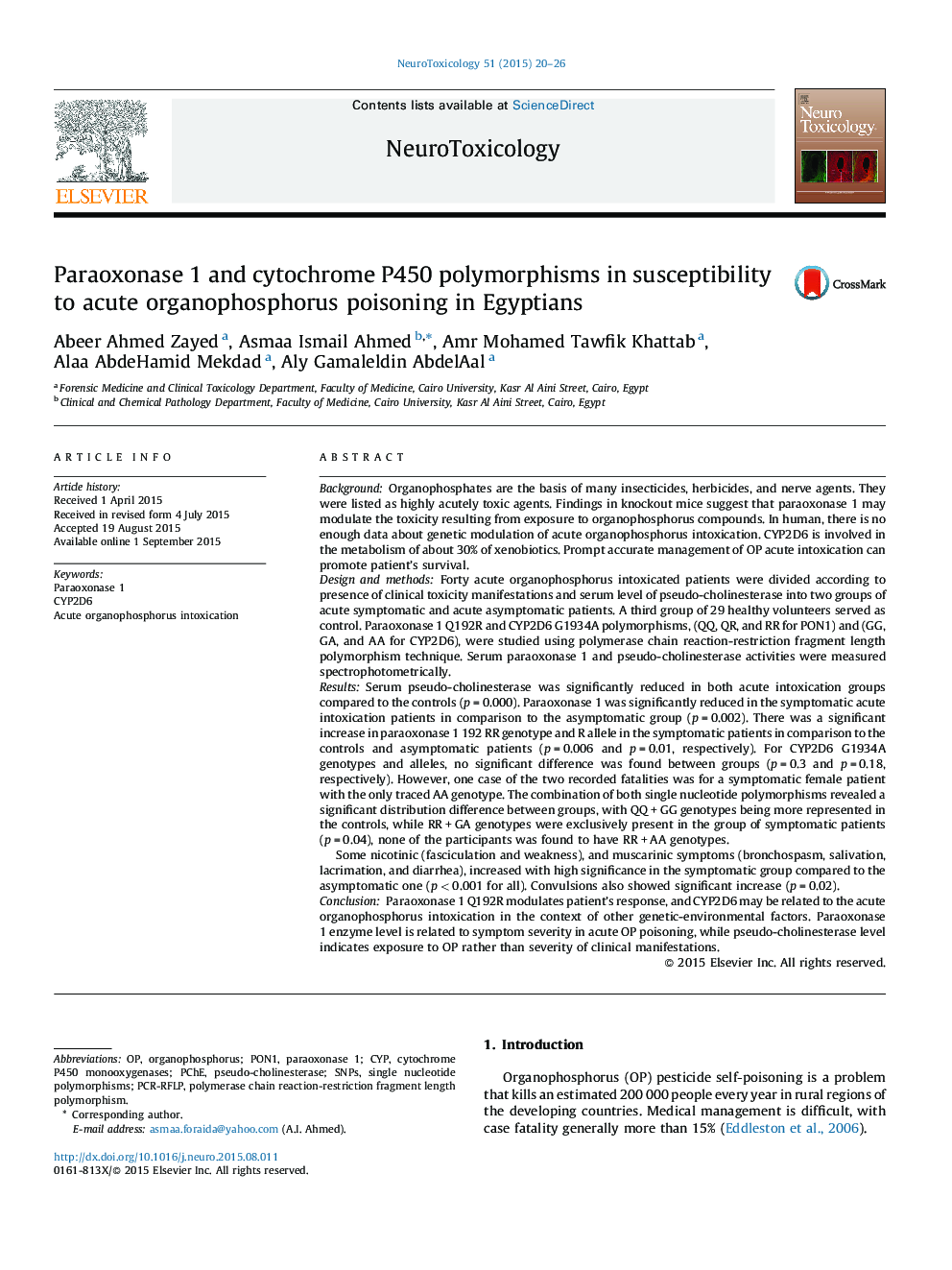| کد مقاله | کد نشریه | سال انتشار | مقاله انگلیسی | نسخه تمام متن |
|---|---|---|---|---|
| 2589462 | 1562043 | 2015 | 7 صفحه PDF | دانلود رایگان |

• Paraoxonase 1 Q192R modulates patient's response to acute OP poisoning.
• CYP2D6 may be related to patient's outcome in acute OP poisoning.
• Genetic testing is essential for acute OP management to improve patient's outcome.
• Paraoxonase 1 enzyme level is related to symptom severity in acute OP poisoning.
• Pseudo-cholinesterase level indicates exposure to OP rather than condition severity.
BackgroundOrganophosphates are the basis of many insecticides, herbicides, and nerve agents. They were listed as highly acutely toxic agents. Findings in knockout mice suggest that paraoxonase 1 may modulate the toxicity resulting from exposure to organophosphorus compounds. In human, there is no enough data about genetic modulation of acute organophosphorus intoxication. CYP2D6 is involved in the metabolism of about 30% of xenobiotics. Prompt accurate management of OP acute intoxication can promote patient's survival.Design and methodsForty acute organophosphorus intoxicated patients were divided according to presence of clinical toxicity manifestations and serum level of pseudo-cholinesterase into two groups of acute symptomatic and acute asymptomatic patients. A third group of 29 healthy volunteers served as control. Paraoxonase 1 Q192R and CYP2D6 G1934A polymorphisms, (QQ, QR, and RR for PON1) and (GG, GA, and AA for CYP2D6), were studied using polymerase chain reaction-restriction fragment length polymorphism technique. Serum paraoxonase 1 and pseudo-cholinesterase activities were measured spectrophotometrically.ResultsSerum pseudo-cholinesterase was significantly reduced in both acute intoxication groups compared to the controls (p = 0.000). Paraoxonase 1 was significantly reduced in the symptomatic acute intoxication patients in comparison to the asymptomatic group (p = 0.002). There was a significant increase in paraoxonase 1 192 RR genotype and R allele in the symptomatic patients in comparison to the controls and asymptomatic patients (p = 0.006 and p = 0.01, respectively). For CYP2D6 G1934A genotypes and alleles, no significant difference was found between groups (p = 0.3 and p = 0.18, respectively). However, one case of the two recorded fatalities was for a symptomatic female patient with the only traced AA genotype. The combination of both single nucleotide polymorphisms revealed a significant distribution difference between groups, with QQ + GG genotypes being more represented in the controls, while RR + GA genotypes were exclusively present in the group of symptomatic patients (p = 0.04), none of the participants was found to have RR + AA genotypes.Some nicotinic (fasciculation and weakness), and muscarinic symptoms (bronchospasm, salivation, lacrimation, and diarrhea), increased with high significance in the symptomatic group compared to the asymptomatic one (p < 0.001 for all). Convulsions also showed significant increase (p = 0.02).ConclusionParaoxonase 1 Q192R modulates patient's response, and CYP2D6 may be related to the acute organophosphorus intoxication in the context of other genetic-environmental factors. Paraoxonase 1 enzyme level is related to symptom severity in acute OP poisoning, while pseudo-cholinesterase level indicates exposure to OP rather than severity of clinical manifestations.
Journal: NeuroToxicology - Volume 51, December 2015, Pages 20–26